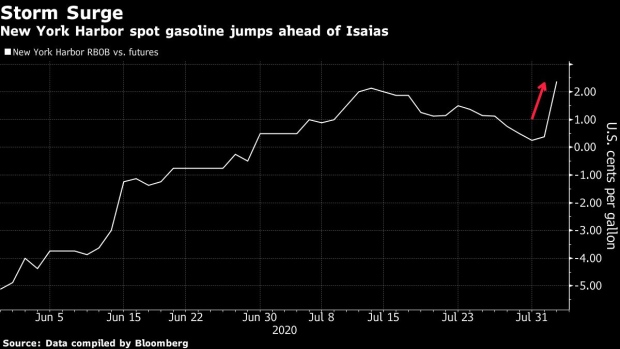Aug 4, 2020
Isaias Bears Down on East Coast Oil Ports and Infrastructure
, Bloomberg News

(Bloomberg) -- Tropical Storm Isaias is driving up regional fuel prices and threatening critical oil infrastructure as it tears through the mid-Atlantic en route to the U.S. Northeast.The benchmark physical gasoline in New York Harbor surged to its strongest level against Nymex gasoline futures since November, data compiled by Bloomberg show. Wholesale gasoline in rack terminal storage in North Carolina and Virginia also ticked up more than 3 cents a gallon.
The U.S. Coast Guard restricted most traffic in Delaware Bay, a critical oil transportation route that serves three refineries that provide fuel to drivers and airports across the Atlantic seaboard. The plants can process about 530,000 barrels of crude oil per day. The biggest East Coast oil port at New York remained open to traffic Tuesday morning but the Coast Guard is likely to issue further restricts as the storm gets closer.
The worst of the storm is expected to pass New York by the evening rush hour.
Nationwide gasoline demand has been roughly level since the start of July due to the re-emergence of the coronavirus after staging recovery beginning in early May. Analysts at FGE predicted last week that gasoline demand would not top 9 million barrels a day at all this year, well short of normal levels.
“Gasoline demand will be down,” said Bob Yawger, director of the futures division at Mizuho Securities USA.
Government gasoline supply data published next week for the period ending August 7 should reflect a large build along the East Coast, Yawger said. Some gasoline cargoes from Europe probably raced to beat the storm, further adding to supply, he said.
(Updates with Port of Delaware status in 3rd paragraph)
©2020 Bloomberg L.P.


